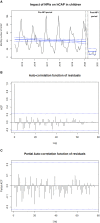Shift in Clinical Profile of Hospitalized Pneumonia in Children in the Non-pharmaceutical Interventions Period During the COVID-19 Pandemic: A Prospective Multicenter Study
- PMID: 35391746
- PMCID: PMC8980475
- DOI: 10.3389/fped.2022.782894
Shift in Clinical Profile of Hospitalized Pneumonia in Children in the Non-pharmaceutical Interventions Period During the COVID-19 Pandemic: A Prospective Multicenter Study
Abstract
Non-pharmaceutical interventions (NPIs) against coronavirus disease 2019 were implemented in March 2020. These measures were followed by a major impact on viral and non-viral diseases. We aimed to assess the impact of NPI implementation in France on hospitalized community-acquired pneumonia (hCAP) frequency and the clinical and biological characteristics of the remaining cases in children. We performed a quasi-experimental interrupted time-series analysis. Between June 2014 and December 2020, eight pediatric emergency departments throughout France reported prospectively all cases of hCAP in children from age 1 month to 15 years. We estimated the impact on the monthly number of hCAP using segmented linear regression with autoregressive error model. We included 2,972 hCAP cases; 115 occurred during the NPI implementation period. We observed a sharp decrease in the monthly number of hCAP after NPI implementation [-63.0% (95 confidence interval, -86.8 to -39.2%); p < 0.001]. Children with hCAP were significantly older during than before the NPI period (median age, 3.9 vs. 2.3 years; p < 0.0001), and we observed a higher proportion of low inflammatory marker status (43.5 vs. 33.1%; p = 0.02). Furthermore, we observed a trend with a decrease in the proportion of cases with pleural effusion (5.3% during the NPI period vs. 10.9% before the NPI; p = 0.06). NPI implementation during the COVID-19 (coronavirus disease 2019) pandemic led not only to a strong decrease in the number of hCAP cases but also a modification in the clinical profile of children affected, which may reflect a change in pathogens involved.
Keywords: COVID-19; children; community-acquired pneumonia; non-pharmaceutical intervention; time series analysis.
Copyright © 2022 Rybak, Ouldali, Angoulvant, Minodier, Biscardi, Madhi, Hau, Santos, Bouvy, Dubos, Martinot, Dommergues, Gras-Le Guen, Launay, Levieux, Zenkhri, Craiu, Lorrot, Gillet, Mezgueldi, Faye, Béchet, Varon, Cohen and Levy.
Conflict of interest statement
The authors declare that the research was conducted in the absence of any commercial or financial relationships that could be construed as a potential conflict of interest.
Figures


References
-
- Collaborators GL. Estimates of the global, regional, and national morbidity, mortality, and aetiologies of lower respiratory tract infections in 195 countries: a systematic analysis for the global burden of disease study 2015. Lancet Infect Dis. (2017) 17:1133–61. 10.1016/S1473-3099(17)30396-1 - DOI - PMC - PubMed
LinkOut - more resources
Full Text Sources

